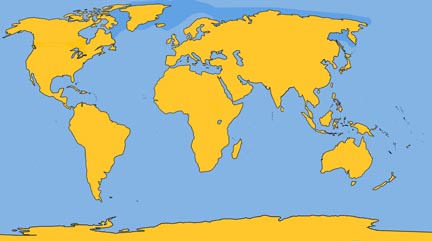 Family: Monodontidae
Family: Monodontidae
Genus: Monodon
Species: M. monoceros Linnaeus, 1758
The narwhal is one of two cetaceans that spends its entire life in Arctic waters, the other being the bowhead whale. (The beluga migrates to warmer water to breed). The narwhal is a very slow swimmer, seldom exceeding 4 mph (6 kmph). Large numbers of narwhals are trapped underwater occasionally by the rapid freezing of openings in the ice above them. Open breathing holes are of such great value that narwhals and walruses will fight for possession of them.
The most notable characteristic of the narwhal is its tusk, usually present only in males. The tusk is a living tooth which grown from the skull through the upper lip to a length of about 8 ft (2.4 m). It is one of two teeth in the upper jaw, although the second seldom erupts from the gum. Spiraling counterclockwise, the tusk contains living pulp. Although theories abound regarding the use or uses to which the narwhal puts its tusk, no one is sure of its function. It is doubtful that it is used to root out prey from the bottom sediments, for the tusk is usually covered with algae. It would seem to be an awkward weapon for combat, although on at least one occasion a male narwhal skull was found to have been penetrated by the tusk of another male.
Like the beluga, the narwhal is an Arctic dweller, inhabiting the circumpolar seas of the Northern Hemisphere. The two animals, however, occupy different niches as belugas frequent coastal waters and venture into rivers, while narwhals are deep-water animals.
Physical Description: Its tusk is the animal’s most obvious physical attribute. The body is somewhat stocky with a rounded, relatively small head.
Color: Color varies with age, from dark blue-gray in juveniles to brown-gray in adults. The dorsal region is covered with leopard-like spots.
Fins and Flukes: A series of small bump on the dorsal region replaces a dorsal fin. The small, rounded flippers usually have upturned tips. The well-developed flukes are pointed at their tips with convex trailing edges. The young closely resemble young belugas.
Length and Weight: Females reach 13 to 15 ft (4 to 4.5 m) and weigh 2,000 lb (900 kg). Males reach 15,5 ft (4.7 m) excluding the tusk, and weigh about 3,500 lb (1,600 kg).
Teeth: Two in the upper jaw only. In the adult male, the left tooth develops into the tusk, which may exceed 8 ft (2.4 m) in length. (In the female, the teeth seldom erupt through the gum). The male’s tusk spirals in a counterclockwise direction.
Feeding: Squid, Greenland halibut, polar cod, flounder, shrimp, rockfish, and crabs.
Breathing and Diving: These animals occasionally find themselves trapped under shrinking breathing holes in the ice, an extremely hazardous situation unless another hole can be found quickly.
Mating and Breeding: Conception probably occurs in mid-April. Calves 5 ft (1.5 m) and about 175 lb (80 kg), are born after a nearly 15-month gestation period. Births occur around mid-July. Females give birth at 3-year intervals.
Herding: Up to 2,000, in groups of between 10 and 20.
Distribution: High Arctic, mainly in deep water, and north polar seas.
Migration: Annual, with movement of the ice. They travel south as far as the coast of Labrador in fall, when ice forms; north to ice pack in spring.
Natural History Notes: These animals often raise their heads above the water exposing their tusks.





